|
 Hygrocybe elegans Hygrocybe elegans
BiostatusPresent in region - Indigenous. Endemic
Images (click to enlarge)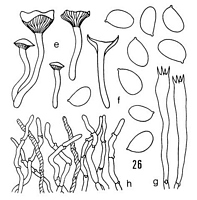
Caption: Hygrocybe elegans HK. (type): e. carpophores. - f. spores. - g. basidia. - h. cuticle | 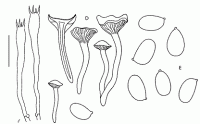
Caption: Fig 4 Hygrocybe elegans Horak. (D-F: PDD 27086, type): D.
basidiomes.>E. spores. F. basidia | 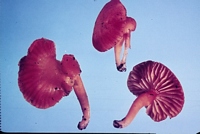
Owner: Herb. PDD | 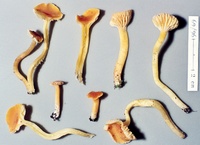
Caption: ZT69-096 , Holotype
Owner: E. Horak: © Creative Commons Attribution-Noncommercial 3.0 New Zealand | 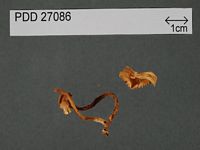
Caption: Dried type specimen
Owner: Herb PDD |
Article: Horak, E. (1990). Monograph of the New Zealand Hygrophoraceae (Agaricales). New Zealand Journal of Botany 28(3): 255-306 (http://www.rsnz.org/publish/abstracts.php).
Description: Pileus-25 mm, at first convex, centre soon becoming flat, finally concave with
upturned margin; brilliant orange (with red tint) at disc, paler or yellow towards
margin; dry, glabrous to minutely felty or subsquamulose (at least in centre),
hygrophanous, margin non-striate. -Lamellae 8-12 (1 -3) decurrent to arcuate;
pale yellow-orange, red tints absent, edges concolorous, entire. - Stipe 20-50
x 2 - 4mm, cylindrical, equal or attenuated towards base; pale yellow like lamellae,
dry, glabrous, hollow, single or caespitose. - Context orange in pileus, yellow
in stipe. - Odour and taste not distinctive. - Chemical reactions on pileus:
KOH, HCI, NH3 - negative.
Spores 6.5-8.5 x 4-5.5 um, ovoid. - Basidia 50-60 x 6-7 um, 4-spored. - Cystidia
absent. - Pileipellis a cutis (or trichoderm) of cylindrical, rather narrow
hyphae (3-8 um diam.), membrane not gelatinised, with yellowish plasmatic pigment;
clamp connections present (Pl. 1, Fig. 2).
Habitat: ECOLOGY: Rare; saprobic on soil among litter under Kunzea ericoides
and in broadleaved-conifer forest (Weinmannia, Dacrydium). February-May.
Distribution: DISTRIBUTION: NZ (NA,WL).
Article: Horak, E. (1973). Fungi Agaricini Novazelandiae I-V. Beihefte zur Nova Hedwigia 43: 200 p.
Description: Pileus 5-20 mm diam., convex -when young, soon becoming flat and concave with upturned margin, deep red-orange at the disc, paler or yellow towards the estriate margin, dry, hygrophanous, minutely felty. Lamellae decurrent, yellowish, red colours lacking, gill edge concolorous. Stipe 20-50 x 2-4 mm, cylindric, equal, yellowish like lamellae, orange or red colours absent, dry, glabrous, hollow, single or fasciculate. Context yellowish. Taste and odor unpleasant. Chemical reactions on pileus: KOH, HCI and NH3 - negative.
Spores 7-8.5 x 4.5-5.5 µm, ovoid, smooth, inamyloid. Basidia 50-60 x 6-7 µm, 4-spored. Cystidia absent. Cuticle a trichoderm or palisade, composed of suberect cylindric, not gelatinized hyphae (3-8 µm diam.), plasmatic pigment present. Clamp connections on septae.
Habitat: Amongst litter on soil under Weinmannia racemosa, Dacrydium cupressinum, etc. New Zealand..
Notes: In the New Zealand bush this species could be confused with H. procera (Stev.) or H. aurantiopallens Hk. but the microscopic characters of both species are distinctly different. H. elegans Hk. apparently belongs to the H. firma (Corner) stirps but is separated mainly in its particular structure of the cuticle. Compared with European species of Hygrocybe the N.Z. fungus is close to H. coccineocrenata (Orton) but differs in addition to other characters by its smaller spores and other type of cuticle.
|